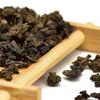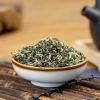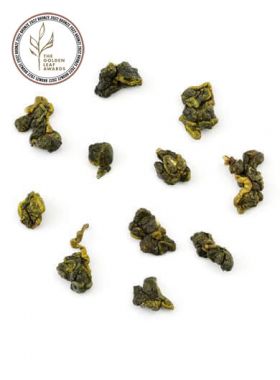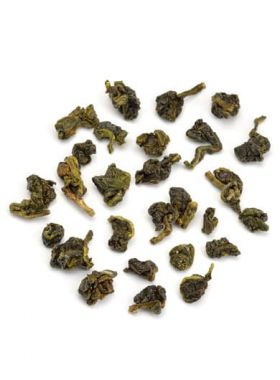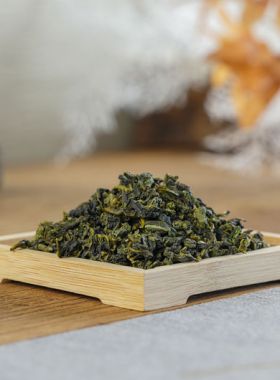-
Fast ShippingFree shipping for orders above $40
to most countries. -
Secure PaymentPay with Paypal, Credit Card …
-
Carefully SelectedFrequently Visit Tea Gardens.
Taste Repetitiously -
15 Days RefundNo Questions Asked
Refund Policy
Anxi Monkey King (Ma Liu Mie) Tie Guan Yin Oolong Tea
Pleasant notes of orchid flowers
Pleasant notes of orchid flowers
| Origin: |
Anxi County, Quanzhou City, Fujian Province, China |
|---|---|
| Season: |
Spring Tea |
|
Harvest Date: |
May 18, 2024 |
| Dry Leaf: |
Rolled to semi-ball shape in sand-green color |
| Aroma: |
Fresh vegetal, orchid floral aroma |
| Liquor: |
Clear yellowish green |
| Taste: |
Smooth, soft and brisk with sweet aftertaste and long-lasting fragrance |
| Tea Bush: |
C. sinensis cv. Tieguanyin |
| Tea Garden: |
Fujing Tea Garden |
| Caffeine: |
Moderate caffeine (less than 20% of a cup of coffee) |
| Storage: |
Store in airtight, opaque packaging; keep refrigerated |
| Shelf Life: |
24 Months |
Angel's Comment:
A tasty and floral Tie Guan Yin which is good for everyday drink.
When Anxi County is mentioned, often the first thought to come is of Anxi tieguanyin, “Iron Goddess” tea. It is well-known both at home and abroad as one of China’s top 10 teas. This particular type of Anxi tieguanyin, Ma Liu Mie ‘Monkey King’ belongs to the zhengchao type of tieguanyin, with a comfortably brisk and smooth flavor.
When it comes to this tea’s name, legend has it that the cliffs where this tea are too steep for people to pick the tea leaves, so monkeys are trained to climb the cliffs and pick the tea for the farmers. Another legend tells that farmers must tie a rope around their waist during picking so they can climb the cliffs and trees much like monkeys.
 |
Cup Method |
 |
Chinese Gongfu Method |
 |
Teacup: 12oz / 355ml |  |
Gaiwan: 3.8oz / 110ml |
 |
212℉ / 100℃ |  |
212℉ / 100℃ |
 |
3 Teaspoons / 5g Tea |  |
7g Tea |
 |
Brewing time: 3- 5 mins |  |
7 steeps: rinse, 30s, 40s, 50s, 60s, 80s, 100s, 120s |
| Rinse time is around 5 seconds |
Fujing Tea Garden sits at an elevation between 500 and 800 meters in Huqiu, one of the main tieguanyin production areas in Anxi. The weather here is warm and moist year-round, with an average temperature between 16 and 19℃ and an annual rainfall of about 1800ml.


After tasting this hand-crafted tieguanyin, Angel Chen from TeaVivre interviewed the master, Ms. Chen Biyi, about the tea.
Angel: Where are the leaves for this tea from?
Ms Chen: Nearly every town in Anxi provides fresh tea leaves. The materials for this tea come from plantations mainly in the areas of Longjuan, Xianghua, Gande, Huqiu, and Xiping.
Angel: Usually when drinking tieguanyin, we may feel a slightly sour taste at the back of our tongue, along with the natural aroma of tieguanyin. Where do these qualities come from?
Ms Chen: This is due to a longer period of spontaneous fermentation before fixation. The sour flavor comes out naturally after the extended period of tossing and oxidation, often lasting for three days.
TeaVivre:A sour flavor might not show that tea has gone bad, or that it is of bad quality: sometimes the sourness is due to something called tuo suan (拖酸), or ‘drawing out the sourness’. Tea leaves are not pan-fired immediately after being picked; they may be put aside for two to three days, during which the leaves may oxidize and spontaneous ferment, which is what develops that sour flavor. This is part of the production method in preparation for ‘stir fixation’.
Angel: I didn’t taste a flavor like that when drinking this nonpareil tieguanyin. Is that a result of the instant stir fixation?
Ms Chen: You’re right. We call this kind of tieguanyin Zheng Chao - ‘zheng’ refers to the middle of the day while ‘chao’ refers to the process of stir fixation, ‘chao qing’, or frying the leaves to end the oxidation process and thus “fix” the current level of oxidation.
TeaVivre: Zheng Chao tieguanyin has a smooth liquid with a clear, heavy flavor, and a strong sweet orchid aroma. The local Fujian people name this characteristic of tieguanyin as “The Charm of Tieguanyin”, or Guan Yin or Yin Yun. It is a standard of discerning the quality of an Iron Goddess. Tea workers will decide whether the tea leaves are ready for stir fixation by their years of experience, and in this way, the flavor of one tieguanyin may vary due to the different experience of the tea makers.
Anxi is in the southeast part of Fujian, with a total area of around 3000 square kilometers. The environment here is definitely suitable for growing tea trees, with an average temperature between 16 and 20℃ and an annual precipitation of 1600-1800mm. According to records in the Anxi County Annals, the tea production in this area began during the Tang Dynasty, then rose through the Ming and Qing Dynasties, and flourished in the last century - overall spanning a history of over a thousand years.
Anxi has been renowned as the capital of tea in Fujian, and in March 1995 was named the Home of Chinese Oolong by the Ministry of Agriculture.

C. sinensis varietal Tieguanyin reproduces through sexual propagation, and takes the form of a shrub with a medium-sized, oval-shaped leaf, deep emerald-green in color. The left dent is thin while the leaf itself is thick yet fragile, and the buds often take on a rich purple-red color. This particular varietal has earned the descriptor “delicious but difficult to grow” since it can flourish only in fertile soil and under appropriate planting and cultivation methods.

Tie Guan Yin is the representative of Chinese oolong tea. Oolong teas were first developed in the early 1700s in Fujian as a cross between nonfermented white and green teas, and fully fermented black teas, with the best of both in a single tea. Oolong quickly became popular throughout eastern China and Taiwan, and in the early 1970s spread to Japan and the rest of the world. Fujian, the home of oolong tea, still produces the finest.
-
5 stars104
-
4 stars46
-
3 stars3
-
2 stars2
-
1 star0



